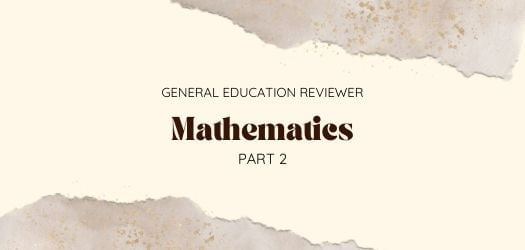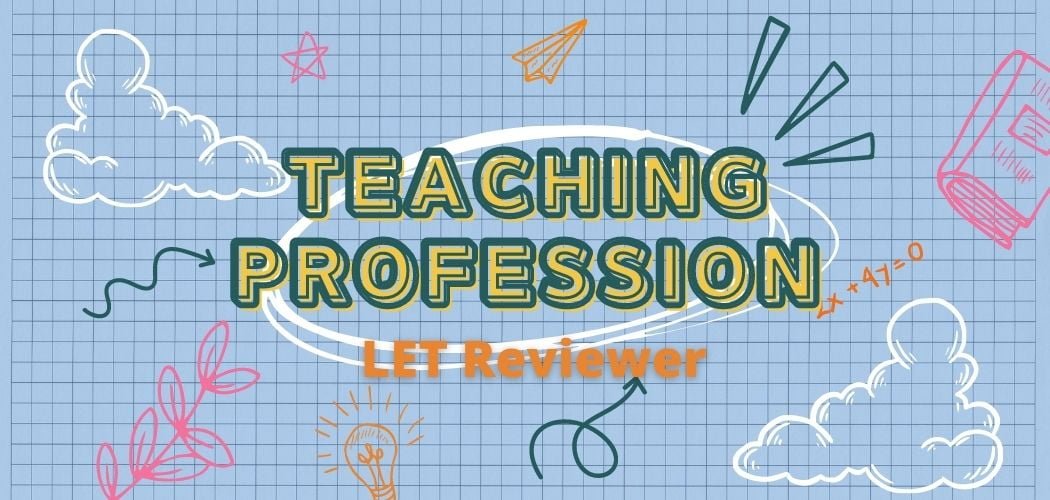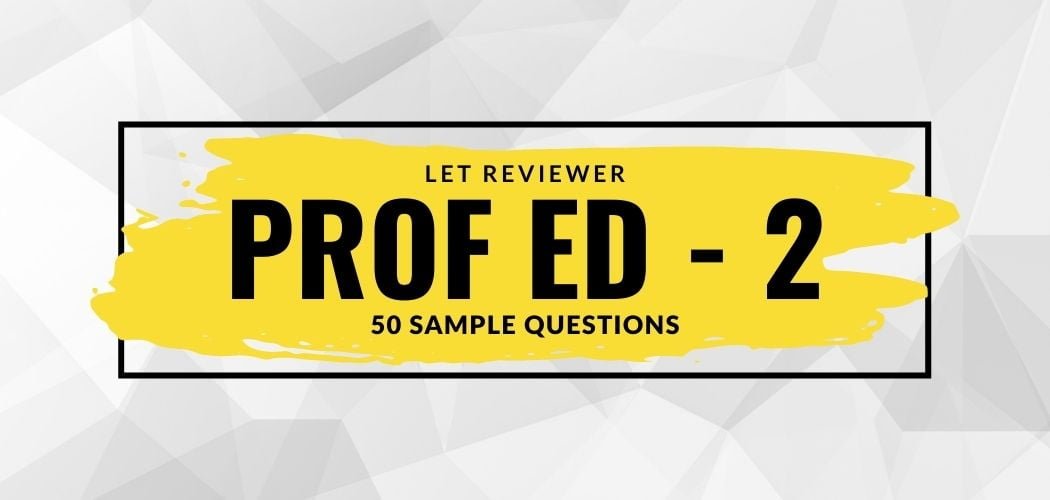This LET Reviewer is intended for both Gen Ed and Math majors. This has 30 multiple-choice questions (with answer key) which need to be completed within one (1) hour.
A full mock exam (50 items) using Google Quiz is also available to get immediate feedback. The link is available at the end of this section. This is the first part of the LET reviewer for the General Education and Math Major series.
Recommended reading
- 5 Research-Based Techniques to Pass Your Next Major Exam
- (13 Tips From Repeaters) How to Pass the LET the First Time
- How to Remember Better: A Study Tip
Math major LET reviewer
Question 1. True or false? Consider a random sample of size n from an x distribution. For such a sample, the margin of error for estimating 𝜇 is the magnitude of the difference between x and 𝜇.
A. False. By definition, the margin of error is the magnitude of the difference between x and 𝜇.
B. True. By definition, the margin of error is the magnitude of the difference between x and 𝜇.
C. True. By definition, the margin of error is the magnitude of the difference between x and 𝜇.✅
D. False. By definition, the margin of error is the magnitude of the difference between x and 𝜇.
Question 2. True or false? A larger sample size produces a longer confidence interval for 𝜇.
A. True. As the sample size increases, the maximal error decreases, resulting in a longer confidence interval.
B. False. As the sample size increases, the maximal error decreases, resulting in a shorter confidence interval.✅
C. True. As the sample size increases, the maximal error increases, resulting in a longer confidence interval.
D. False. As the sample size increases, the maximal error increases, resulting in a shorter confidence interval.
Question 3. True or false? Every random sample of the same size from a given population will produce exactly the same confidence interval for 𝜇.
A. True. Different random samples may produce different x values, resulting in different confidence intervals.
B. False. Different random samples may produce different x values, resulting in different confidence intervals.✅
C. False. Different random samples may produce different x values, resulting in the same confidence intervals.
D. True. Different random samples will produce the same x values, resulting in the same confidence intervals.
Question 4. True or false? If the sample mean of a random sample from an x distribution is relatively small, then the confidence interval for 𝜇 will be relatively short.
A. True. The maximal error of estimate controls the length of the confidence interval depends on the value of x.
B. False. The maximal error of estimate controls the length of the confidence interval regardless of the value of x.✅
C. True. The maximal error of estimate controls the length of the confidence interval regardless of the value of x.
D. False. The maximal error of estimate controls the length of the confidence interval depends on the value of x.
Question 5. True or false? If the sample mean x of a random sample from an x distribution is relatively small, when the confidence level c is reduced, the confidence interval for 𝜇 becomes shorter.
A. False. As the level of confidence decreases, the maximal error of estimate increases.
B. True. As the level of confidence decreases, the maximal error of estimate decreases.✅
C. False. As the level of confidence decreases, the maximal error of estimate decreases.
D. True. As the level of confidence decreases, the maximal error of estimate increases.
Question 6. As the degrees of freedom increase, what distribution does the student’s t-distribution become more like?
A. chi-square
B. binomial
C. uniform
D. standard normal✅
Question 7. What is a null hypothesis?
A. A specific hypothesis where the claim is that the population parameter is equal to 0.
B. Any hypothesis that differs from the original claim being made.
C. A working hypothesis making a claim about the population parameter in question.✅
D. A specific hypothesis where the claim is that the population parameter does not equal 0.
Question 8. What is an alternate hypothesis?
A. A specific hypothesis where the claim is that the population parameter does not equal 0.
B. A specific hypothesis where the claim is that the population parameter is equal to 0.
C. Any hypothesis that differs from the original claim being made.✅
D. A working hypothesis making a claim about the population parameter in question.
Question 9. If we fail to reject (i.e., “accept”) the null hypothesis, does this mean that we have proved it to be true beyond all doubt?
A. Yes, if we fail to reject the null, we have found evidence that the null is true beyond all doubt.
B. No, it suggests that the evidence is not sufficient to merit rejecting the null hypothesis.✅
C. No, it suggests that the null hypothesis is true only some of the time.
D. Yes, it suggests that the evidence is sufficient to merit rejecting the alternative hypothesis beyond all doubt.
Question 10. If we reject the null hypothesis, does this mean that we have proved it to be false beyond all doubt?
A. No, the test was conducted with a risk of a type I error.✅
B. Yes, if we reject the null that suggests that it is false beyond all doubt.
C. No, the test was conducted with a risk of a type II error.
D. Yes, the test was conducted with a risk of a type I error.
Question 11. Name of the bias that can occur when not everybody from the population is included in the sample.
A. Undercoverage✅
B. Sampling bias
C. Convenience sampling
D. Response bias
Question 12. What is the difference between descriptive and inferential statistics?
A. Inferential statistics only concerns the sample while descriptive statistics concerns the underlying population
B. Descriptive statistics is used with discrete variables, inferential statistics is used with continuous variables.
C. Inferential statistics is used with discrete variables, descriptive statistics is used with continuous variables.
D. Descriptive statistics only concerns the sample, inferential statistics concerns the underlying population.✅
Question 13. What is the central limit theorem?
A. It says that the sampling distribution forms a bell shape given that the sample is large enough and the population distribution is bell-shaped.✅
B. It says that the mean is centered if the sample size is infinity.
C. It says that the sampling distribution forms a bell shape given that the sample is large enough.
D. It says that the population distribution approximates a bell shape given that the sample is large enough.
Question 14. What can you say if a sample distribution (very large sample size) is very different from the population distribution?
A. You have to do further research.
B. The sample is biased and does not represent the population well.✅
C. No issues and may proceed with the analysis.
D. Population is biased.
Question 15. Suppose you would like to estimate the proportion of the satisfied customer. Which of the following would be the best point estimate to use?
A. The number of satisfied customers out of a random sample of 100 customers.
B. The proportion of satisfied customers out of a random sample of 100 customers.
C. The proportion of satisfied customers out of the latest 100 customers to contact customer services.✅
D. The average customer satisfaction rating given by a random sample of 100 customers.
Question 16. You received several complaints that a specific type of doll you sell, the DollX, is defective. You decided to test 5 out of the 50 DollX chains you have in stock to determine whether or not you should report the fault to the supplier. What is the population of interest in this study?
A. All dolls
B. All previously sold DollX
C. All DollX✅
D. The 5 selected DollX
Question 17. You received several complaints that a specific type of doll you sell, the DollX, is defective. You decided to test 5 out of the 50 DollX chains you have in stock to determine whether or not you should report the fault to the supplier. What is the sample of interest in this study?
A. All dolls
B. All previously sold DollX
C. All DollX
D. The 5 selected DollX✅
Question 18. Which of the statement(s) is/are correct?
I. A disadvantage of a telephone interview compared to a face-to-face questionnaire is that people tend to be less patient.
II. The cheapest way of collecting data is an online survey.
A. Statement II is correct, statement I is incorrect.
B. Statement I is correct, statement II is incorrect.
C. Both statements are incorrect.
D. Both statements are correct.✅
Question 19. Do the probabilities add up to 1? Should they add up to 1?
A. Yes, but they should not because these values do not cover the entire sample space.
B. Yes, because these values cover the entire sample space.✅
C. No, because these values do not cover the entire sample space.
D. No, but they should because these values cover the entire sample space.
Question 20. A sample space must be collectively exhaustive and mutually exclusive.
A. true✅
B. false
C. either
D. neither
Question 21. Discrete random variables arise from measurement.
A. true
B. false✅
C. either
D. neither
Question 22. Which of the following is a continuous variable?
A. number of traffic fatalities per year in the state of Florida
B. number of ships in Pearl Harbor on any given day
C. time required to drive from home to college on any given day✅
D. number of days someone lives
Question 23. What does it mean to say that the trials of an experiment are independent?
A. One outcome is less likely to happen than the other outcomes
B. The outcome of one trial affects the probability of success on any other trial.
C. The outcome of one trial does not affect the probability of success on any other trial.✅
D. One outcome is more likely to happen than the other outcomes.
Question 24. Which of the following is not a continuous variable?
A. time to solve a problem
B. temperature
C. height
D. number of children in a family✅
Question 25. Real limits are important whenever you are measuring a(n) _____ variable.
A. independent✅
B. dependent
C. discrete
D. continuous
Question 26. What does a standard score measure?
A. the number of standard deviations a measurement is from the mean✅
B. the number of standard deviations a measurement is from the lowest value
C. the number of standard deviations a measurement is from the highest value
D. the number of standard deviations that are present under a normal curve
Question 27. Does a raw score less than the mean correspond to a positive or negative standard score? What about a raw score greater than the mean?
A. Raw scores less than the mean will have negative standard scores; raw scores above the mean will have positive standard scores.✅
B. Raw scores less than the mean will have positive standard scores; raw scores above the mean will have negative standard scores.
C. Raw scores below and above the mean will have negative standard scores.
D. Raw scores below and above the mean will have positive standard scores.
Question 28. If car insurance rates for teenagers is approximately normally distributed with a standard deviation of $620 per year, find the mean insurance rate for teenagers if 10.56% of teenagers pay more than $3,000 annually for car insurance.
A. $2,225✅
B. $3,775
C. $2,935
D. $2,380
Question 29. Normal distribution can have a mean that corresponds to a negative number.
A. true✅
B. false
C. sometimes
D. neither
Question 30. A z-score of z = −2.00 indicates a position in a distribution _______.
A. below the mean by 2 points
B. above the mean by a distance equal to 2 standard deviations
C. below the mean by a distance equal to 2 standard deviations✅
D. above the mean by 2 points
Exam coverage
For the Mathematics portion of the Gen Ed exam, here’s the coverage:
- fundamentals of math
- plane geometry
- elementary algebra
- probability and statistics
For our future secondary education teachers, here’s the exam coverage for your area of specialization:
- probability and statistics
- arithmetic and number theory
- business math
- basic and advanced algebra
- plane and solid geometry
- trigonometry
- analytical geometry
- calculus
- modern geometry
- linear and abstract algebra
- history of mathematics
- mathematical investigation
- instrumentation and assessment



